
Catalog excerpts

Kiosk systems in border control Why kiosks play a key role in the launch of the European Entry/Exit System
Open the catalog to page 1
Introduction In connection with the Smart Borders Initiative, the European Parliament has agreed to introduce the common biometric Entry/Exit System, EES for short, in order to register all travellers from Third Countries. This means that, as of 2022, nationals of Third Countries will have to register with four fingerprints and a facial image when entering Schengen countries through land, sea and air borders. The biometric data is stored in the EES together with biographical data of the person and other information taken from the travel document. The many new and equally complex and...
Open the catalog to page 2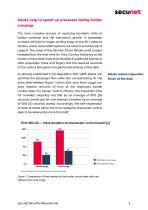
Kiosks help to speed up processes during border crossings The more complex process of capturing biometric data at border crossings and the continuous growth in passenger numbers will lead to longer waiting times at the EU’s external borders unless automated systems are used to provide help & support. The study of the German Smart Borders pilot project revealed that the wait time for Third Country Nationals at the border control desk more than doubles if additional biometric data acquisition (face and finger) and the required searches of the central EES system are performed entirely at the...
Open the catalog to page 3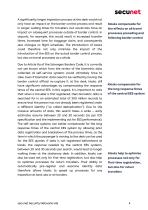
A significantly longer inspection process at the desk would not only have an impact on the border control process and result in longer waiting times for travellers, but would also have an impact on subsequent processes outside of border control. In airports, for example, this would result in increased transfer times, increased time for baggage claim, and consequently following border control also changes to flight schedules. The introduction of kiosks could therefore not only minimise the impact of the introduction of the EES on the actual border control process, but also on travel...
Open the catalog to page 4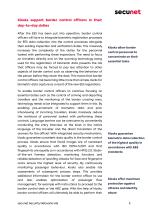
Kiosks support border control officers in their day-to-day duties After the EES has been put into operation, border control officers will have to integrate biometric registration processes for EES data collection into the control processes alongside their existing inspection and verification duties. This massively increases the complexity of the duties for the personnel tasked with performing these inspections. The need to focus on travellers directly and on the scanning technology being used for the registration of biometric data presents the risk Kiosks allow border control personnel to...
Open the catalog to page 5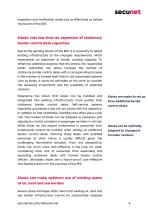
inspection and verification duties just as effectively as before the launch of the EES. Kiosks cost less than an expansion of stationary border control desk capacities Due to the pending launch of the EES, it is necessary to adapt existing infrastructure to the changed requirements, which necessitates an expansion of border crossing capacity. To offset the additional expense that this entails, the responsible public authorities can either increase the number of stationary border control desks with a corresponding increase in the number of trained staff and/or use automated systems such as...
Open the catalog to page 6
and certainly not at short notice. Despite this, longer queues are to be expected at border control points after the launch of the EES due to the more extensive controls it entails. This need for more time to control travellers and the limited available space for inbound and outbound travellers means that a flexible solution is preferred. The procurement of kiosks provides a great deal of flexibility Kiosks provide a great as the waiting areas of self-service systems and stationary desks can be kept separate from each another – kiosks can also make flexible use of available space further...
Open the catalog to page 7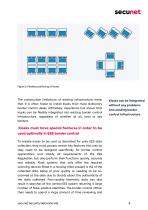
Figure 2: Flexible positioning of kiosks The construction limitations of existing infrastructure mean that it is often faster to install kiosks than more stationary border control desks. Ultimately, experience has shown that kiosks can be flexibly integrated into existing border control infrastructure, regardless of whether at air, land or sea Kiosks can be integrated without any problems into existing border control infrastructure Kiosks must have special features in order to be used optimally in EES border control To enable kiosks to be used as described for prior EES data collection,...
Open the catalog to page 8
evaluating these, which eliminates any of the advantages that a kiosk offers. EES kiosks must ensure that facial images and fingerprints are Adaptive camera height captured with the highest quality possible. In particular, facial adjustment guarantees images must be taken in accordance with ISO 19794-5:2011 fast, high-quality facial while fingerprints must be captured in accordance with NFIQ 2.0. Only an integrated camera that automatically adapts its capture position to the passenger’s height by means of height adjustments can guarantee optimum, fast and high-quality capturing of facial...
Open the catalog to page 9
Accordingly, when procuring kiosks, particular value should be placed on ensuring that they can take high-quality scans of biometric data, that they offer superior anti-circumvention technology using PAD, and that they feature integrated security functions. Not every kiosk automatically satisfies EES requirements under EU Regulation 2017/2226. secunet Security Networks AG
Open the catalog to page 10
Summary The introduction of the European Entry/Exit System presents major challenges for border control. High-quality capturing of facial images and fingerprints and the associated communication with the EES central system will require additional steps, which will lead to a significant increase in the time needed for border control of each individual traveller. This will also have a direct impact on processes outside the border control, such as timetables, flight schedules and baggage handling. However, the intelligent use of kiosks as process accelerators for automation, selfservice and...
Open the catalog to page 11All Secunet Security Networks AG catalogs and technical brochures
-
secunet Success Story PKI
7 Pages
-
Factsheet secunet easygate
4 Pages
-
Factsheet secunet easytower
4 Pages
-
Factsheet secunet easykiosk
4 Pages
-
secunet Success Story EES
7 Pages
-
Factsheet secunet biomiddle
4 Pages
-
Factsheet secunet bocoa
4 Pages









